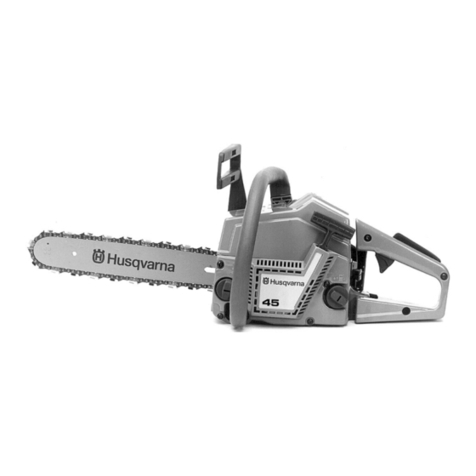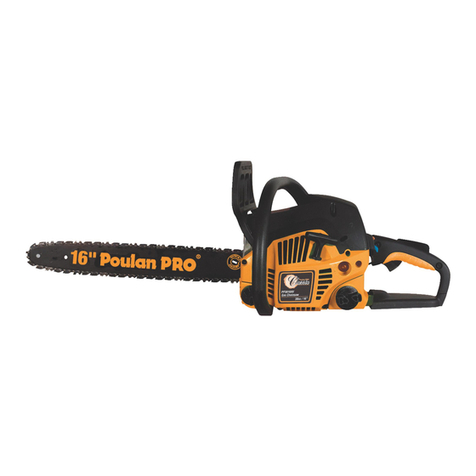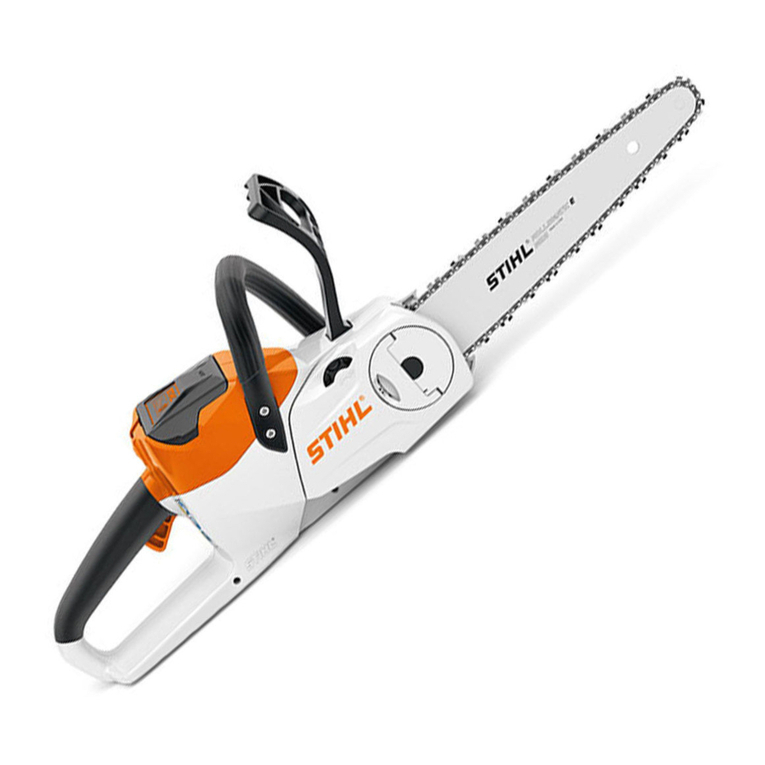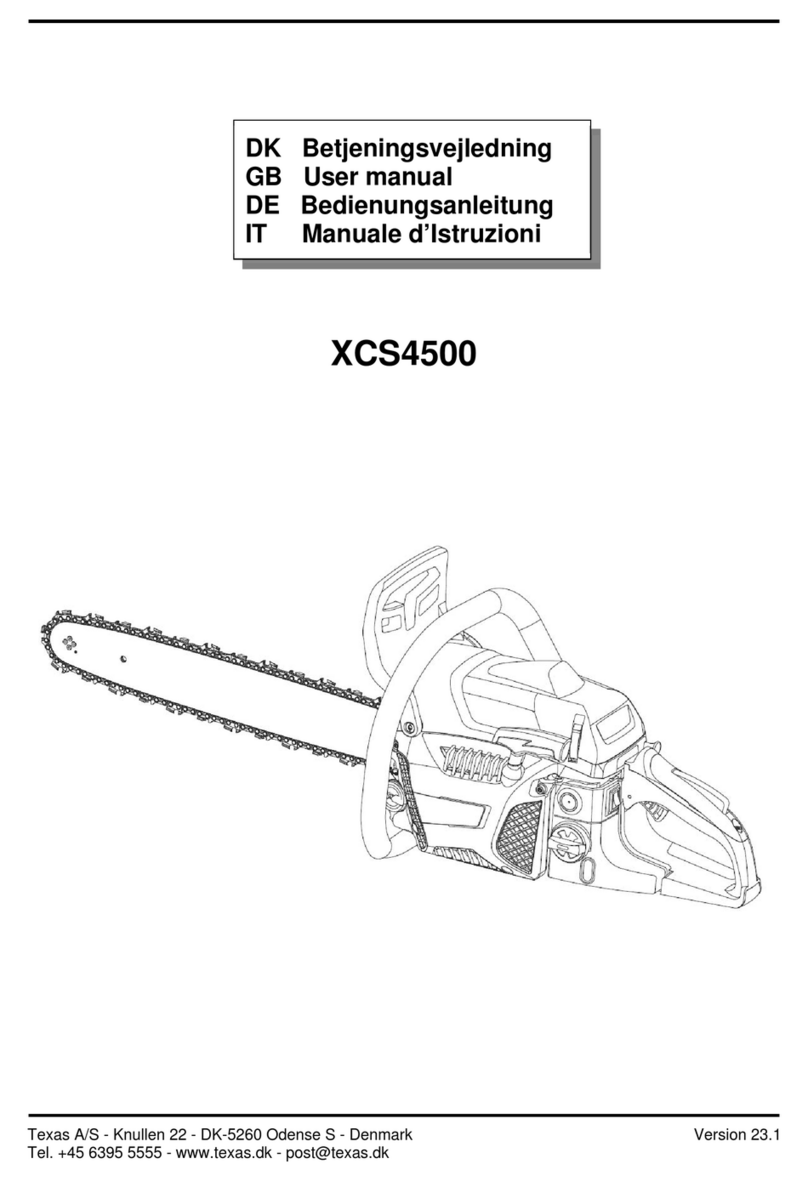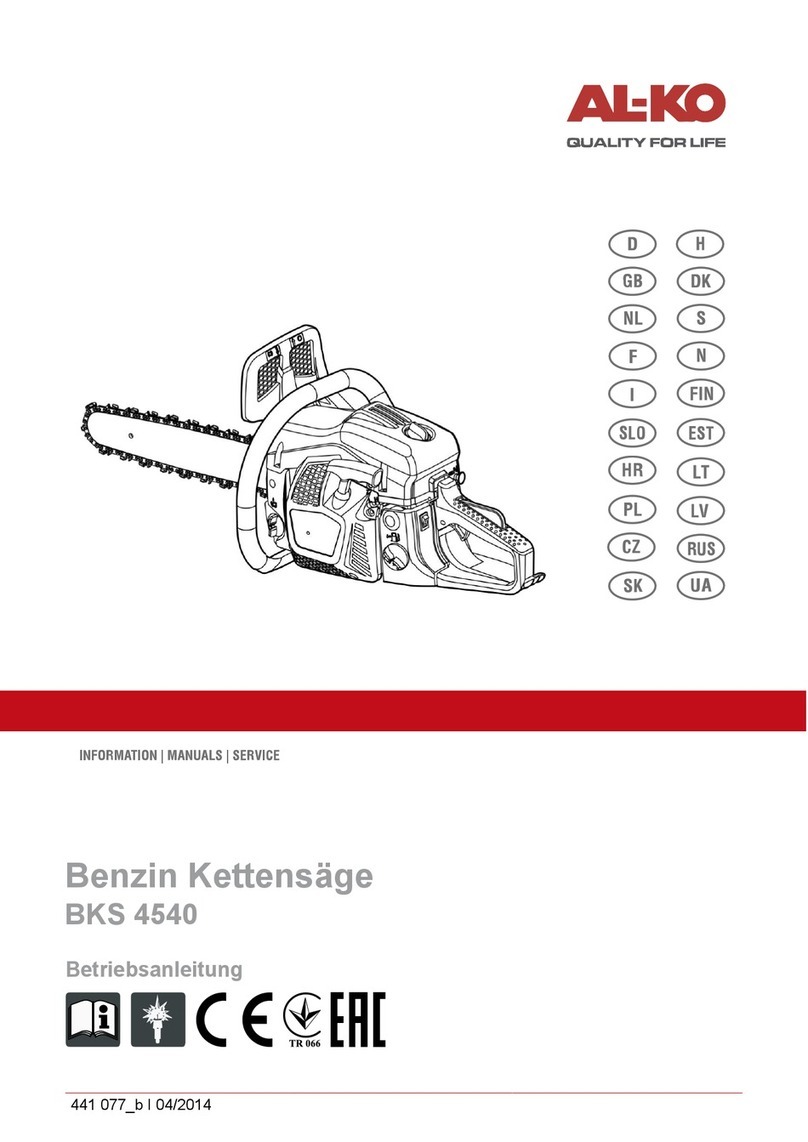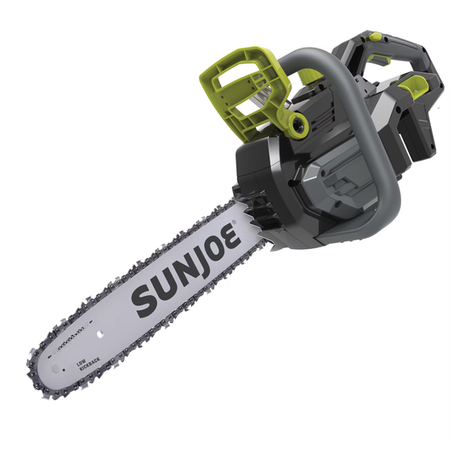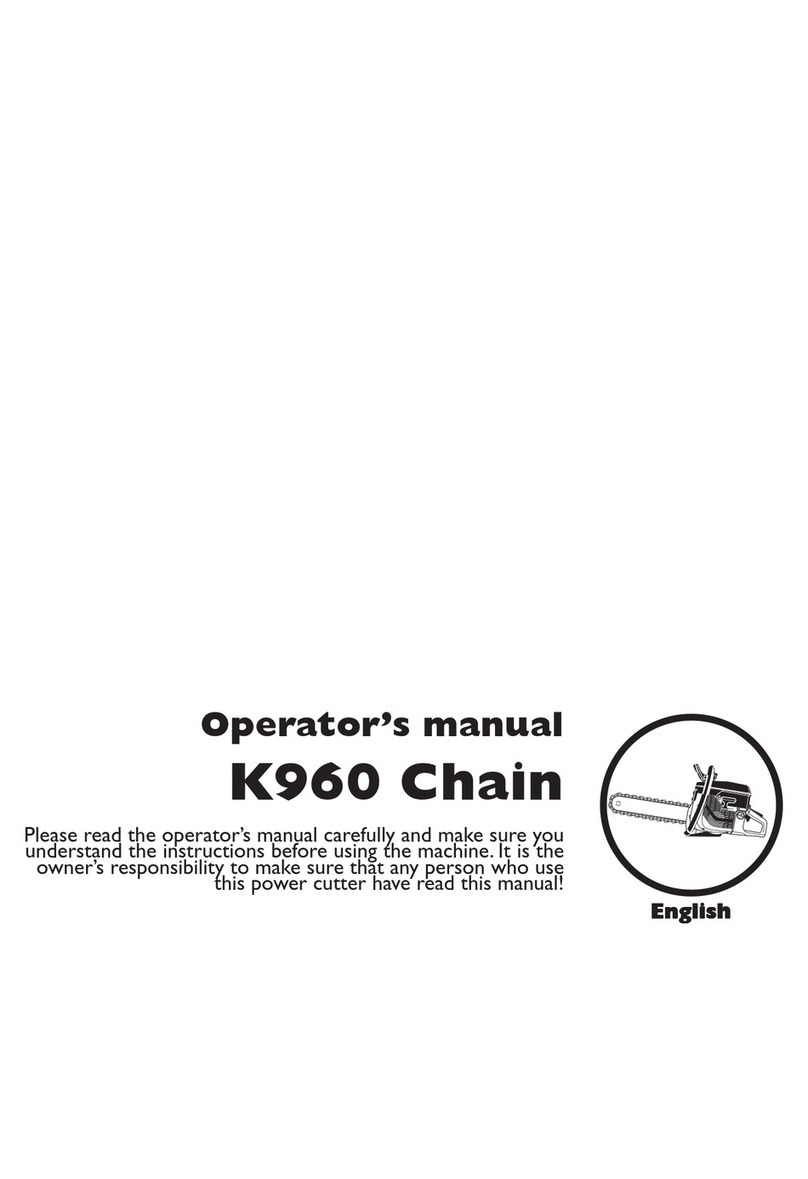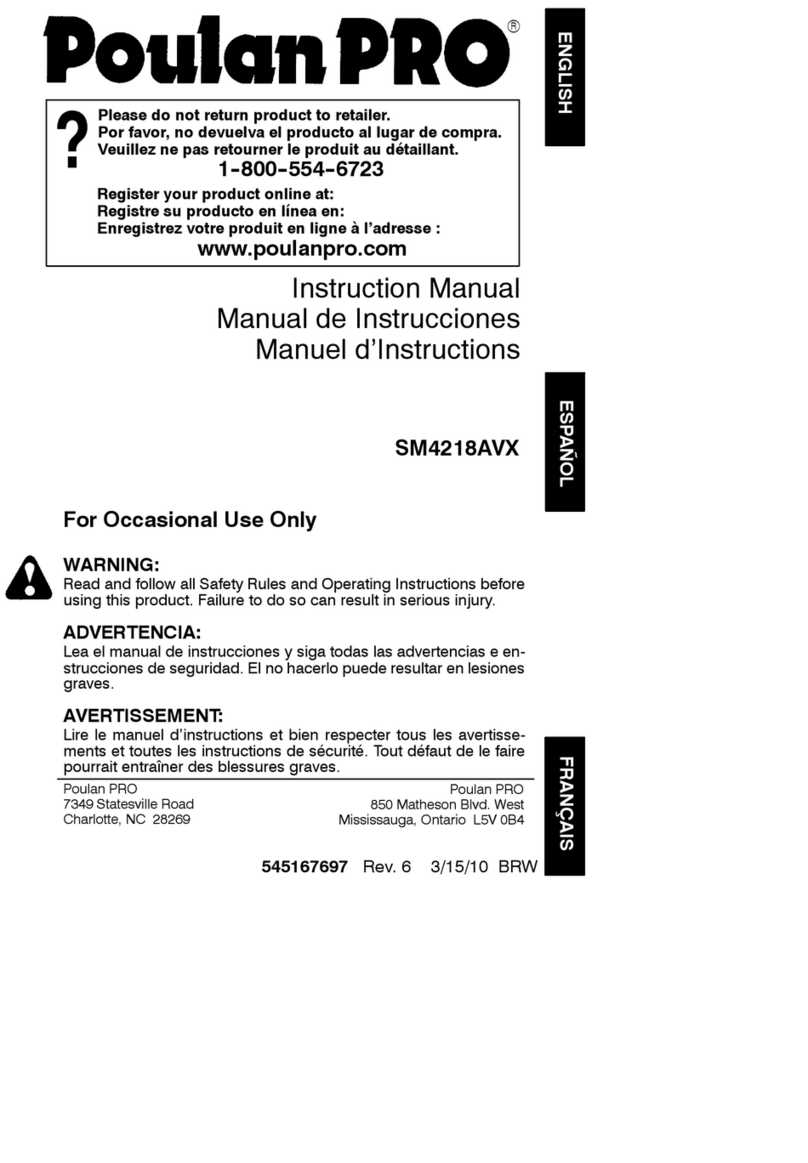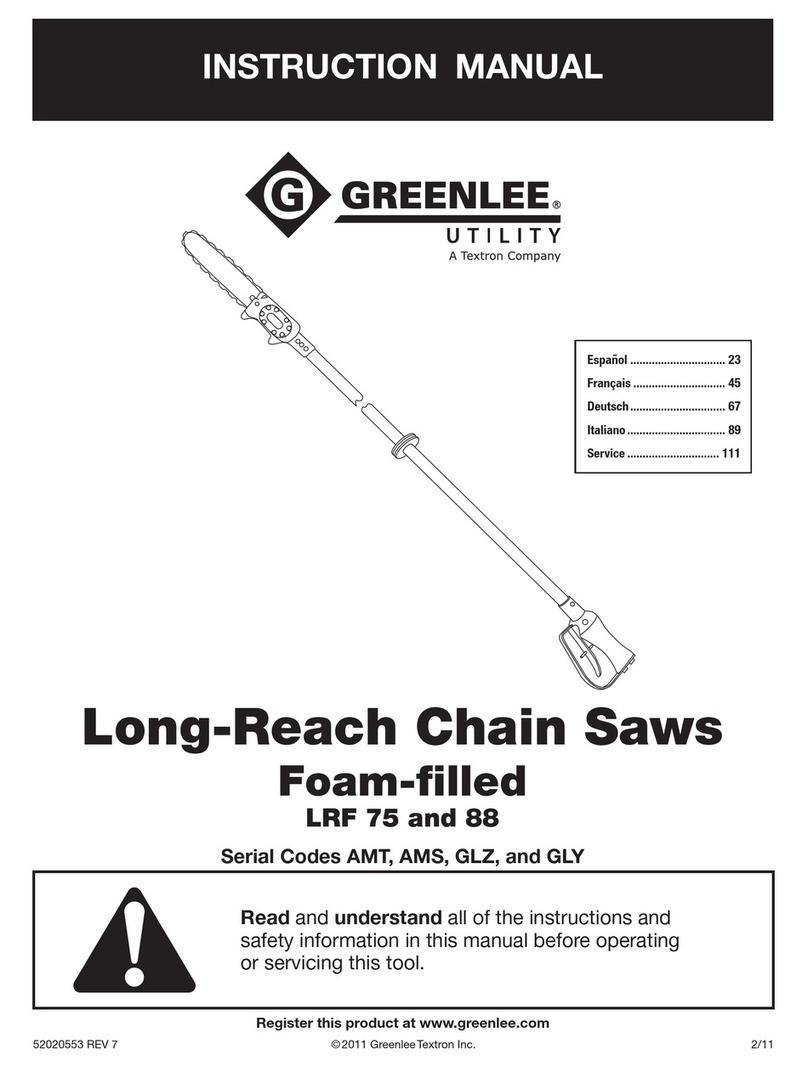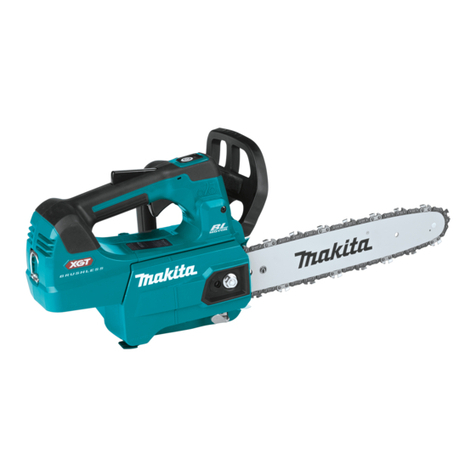bonomi MITO QTHF User manual

·
·
·

—

—

—

—

—

—

—

-
-
-
-
-
-
-
-
-
—

—

—

—

—

Elettrosega
Mito
QTHF English
14
Your MITO electric chainsaw is an electric power tool designed to perform straight cuts
into concrete, reinforced concrete, stone, using the proper diamond chain and bar. The
product needs sufficient clean water to operate and cool bar and chain through the water
inlet system. Powerful and lightweight, this product is designed to perform finishing jobs
by professional cutters and any kind of contractors. Follow general contractor, local and
national regulations how to dispose of slurry generated during operating the saw.
Operator needs to be properly trained.
Warning read al safety precautions and instruction. Please keep these safety
precautions and instruction for the future
Do not use this product to cut wood, plastic or other materials not listed above.
Do not use bars and chains different from the ones defined in this user manual.
In the following text, figures are identified by numbers,
details inside figures by letters. Figures are depicted on the
first pages of this user manual.
1) G
Ge
en
ne
er
ra
al
l
s
sa
af
fe
et
ty
y
p
pr
re
ec
ca
au
ut
ti
io
on
ns
s
WARNING! Read all instructions. Failure to follow all
instructions listed below may result in electric shock, fire
and/or serious injury. The term "power tool" in all of the
warnings listed below refers to your mains operated (corded)
power tool or battery operated (cordless) power tool.
SAVE THESE INSTRUCTIONS
1) Security of employment
a) Keep working area clean and well lit. Cluttered
and dark areas invite accidents.
b) Do not operate power tools in explosive
atmospheres, such as in the presence of
flammable liquids, gases or dust. Power tools
create sparks which may ignite the dust or fumes.
c) Keep children and bystanders away while
operating a power tool. Distractions can cause
you to lose control.
2) Electrical safety
a) The mains plug of the electric tool must fit into
the socket. The plug must not be changed in
any kind. Do not use adapter plugs together
with earthed electric tools. Unmodified plugs
and fitting sockets reduce the risk of electric
shock.
b) Avoid body contact with earthed surfaces, like
tubes, heatings, cookers and fridges. There is a
higher risk of electric shock when your body is
earthed.
c) Keep your electric tool away from rain or
wetness. The infiltration of water into an electric
tool increases the risk of an electric shock.
d) Do not divert the cord from its intended use
from carrying or hanging up the electric tool,
or for pulling the plugs from the socket. Keep
the cord away from heat, oil, sharp edges or
moving device parts. Damaged or tangled cords
increase the risk of an electric shock.
e) If you work outside with your electric tool, only
use extension cords that are appropriate for
outside use. The use of a extension cord which is
appropriate for outside use reduces the risk of an
electric shock.
f) If the use of the electric tool in humid areas is
inevitable, use a ground fault circuit.
3) Personal safety
a) Stay alert, watch what you are doing and use
common sense when operating a power tool.
Do not use a power tool while you are tired or
under the influence of drugs, alcohol or
medication. A moment of inattention while
operating power tools may result in serious
personal injury.
b) Use safety gear: always wear eye protection.
Safety equipment such as dust mask, non-skid
safety shoes, gloves, hard hat, and hearing
protection used for appropriate conditions will
reduce personal injuries.
c) Avoid accidental starting. Ensure the switch is
in the off position before plugging in. Carrying
power tools with your finger on the switch or
plugging in power tools that have the switch on
invites accidents.
d) Remove any adjusting key or wrenches before
turning the power tool on. A wrench or a key left
attached to a rotating part of the power tool may
result in personal injury.
d) Do not overreach. Keep proper footing and
balance at all times. This enables better control of
the power tool in unexpected situations.
e) Dress properly. Do not wear loose clothing or
jewellery. Keep your hair, clothing and gloves
away from moving parts. Loose clothes, jewellery
and long hair can be caught in moving parts.
f) If devices are provided for the connection of
dust extraction and collection facilities, ensure
these are connected and properly used. Use of
these devices can reduce dust related hazards.

Elettrosega
Mito
English
g) Use auxiliary handles supplied with the tool.
Loss of control can cause personal injury.
4) Power tool use and care
a) Do not overload the device. Use the appropriate
electric tool for your work. With the appropriate
electric tool you work better and saver in the
declared range of performance. Do not force
the power tool. Use the correct power tool for
your application. The correct power tool will do
the job better and safer at the rate for which it was
designed.
b) Do not use the electric power tool if the switch
does not turn it on and off or is damaged. Any
power tool that cannot be controlled with the switch
is dangerous and must be repaired.
c) Disconnect the plug from the power source
before making any adjustments, changing
accessories, or storing power tools. Such
preventive safety measures reduce the risk of
starting the power tool accidentally.
d) Store idle electric power tools out of the reach
of children and do not allow persons unfamiliar
with the power tool or these instructions to
operate the power tool. Power tools are
dangerous in the hands of untrained users.
e) Maintain electric power tools. Check for
misalignment or binding of moving parts,
breakage of parts and any other condition that
may affect the power tools operation. lf
damaged, the power tool repaired before use.
Many accidents are caused by poorly maintained
power tools.
f) Keep cutting tools sharp and clean. Properly
maintained cutting tools with sharp edges do jam
and are easier to control.
g) Maintain electric tools with care. Check if
movable parts function correctly and do not
jam, if parts are broken or damaged in that way,
that the function of the electric tool affected.
Have damaged parts repaired before using the
device. Many accidents originate from bad
maintained electric tools.
h) Use the power tool, accessories and tools etc.,
in accordance with these instructions and in
the manner intended for the particular type of
power tool, taking into account the working
conditions and the work to be performed. Use of
the power tool for operations different from
intended could result in a hazardous situation.
5) Service
Have your electric power tool serviced by a
qualified repair person using only original or
identical replacement parts. This will ensure that
the safety of the power tool is maintained.
6) Particular information
a) This diamond chain saw is only intended for
industrial use and may only be operated by
trained personnel.
b) Proper use extends only to the sawing of rock,
concrete and masonry. The saw must not be
used for cutting pure metals. For the cutting of
ductile iron pipes special chains are available in the
specialist trade
c) For operation the relevant regulations must be
observed
d) Power tools must regularly (approx. 6 months)
be checked on safety by a specialist according
to BGV A3.
e) Never deposit the chain saw until the chain has
come to a complete stop. The rotating chain can
get into contact with the surface whereby you may
loose control of the chain saw.
f) Do not operate the chain saw while you carry it.
Your clothes can be captured by accidental contact
with the diamond chain.i
g) f a disc saw is used for cutting, care must be taken
that the thickness of the cutting blade matches to
the diamond chain. Never use a disc saw with a
conventional cutting disc for cutting. The narrow
saw groove produced in this case leads to a
jamming of the diamond chain and can lead to
dangerous kickback.
2
2)
)
S
Sa
af
fe
et
ty
y
r
ru
ul
le
es
s
f
fo
or
r
y
yo
ou
ur
r
c
ch
ha
ai
in
ns
sa
aw
w
2.1) Earth (Ground)
a) the metallic parts of your chainsaw earthed. Make
sure that the power supply is properly earthed.
b) make sure that the socket, extension cords and
multiple sockets you use, have the earth
connection.
Warning:
for your safety, it is important
that the whole system (electrical system,
extension cords, sockets etc.) is connected
to the earth. If you are not sure, ask a
qualified electrician for a check.
2.2) Water supply: Safety rules
a) Connect the frequency converter FU6U via the
plug-in nipple (25) to the water supply. The ball
valve must at any time be on the side of the water
supply. Now connect the FU6U with the chain
saw via a water hose with a length of approx. 4,2
m (length of the cable).
b) Attention: water pressure max. 3 bar. Water
may only be connected to ball valve, as
otherwise a damage on the casing may
appear by upcoming water pressure.
c) Please use a GARDENA coupling as the
connecting piece to the machine and the frequency
converter. This can be obtained from a garden
center or builders’ merchant made of plastics. A
water coupling of brass of high quality can be
received directly from Bonomi.
d) Use only clean water, as dirty water will
considerably disturb the heat exchange on the
cooling surface and thereby the motor can be
totally damaged.
Else the seals wear out very quickly.
2.3) Checks and precautions to avoid structural
damage and damage to a building
a) Before operating, talk to the construction manager
or the planner in order to make sure that cutting
doesn’t:
b) damage the structure of the building and change
the structural characteristics of the construction;
c) damage any water or gas pipeline or any electric
mains.
d) Particularly care if presence of gas pipeline, cutting
iron sparks is present and can be a comburent for
the gas
2.4) Checks and precautions to avoid damage caused
by the fall of the cut out work piece
a) before operating, make sure that the possible falling
of the cut out work piece doesn't make any
damage. In any case, secure the area where the
work piece can fall and signal the danger;

Elettrosega
Mito
QTHF English
16
b) if the possible fall of the cut out work piece can
damage anybody or anything, make sure to have
a proper system in place to secure it safely.
2.5) Fastening the work piece and size of the work piece
c) if you are operating on a block not part of a
structure, fasten it in order to prevent its movement.
Prevent the work piece from shifting, moving or
falling when you are cutting.
2.6) Suitable Bars and Chians
d) Use bars and chains for wet cutting. Bars and chain
for concrete, reinforced concrete, stone, are
suitable for your product. Your product is not
suitable to cut wood, plastics, metals (except
reinforcing bars in concrete).
Use only bars and chains provided by Bonomi
or authorized dealer.
2.7) Bars and Chains not to be used
e) Do not use bars and chains other than the ones
prescribed by Bonomi. Do not use chains for
wood, tungsten carbide chains or chains for
masonry. Chains for wood or masonry generate a
kickback effect when plunging: for this reason this
kind of chainsaws are equipped with specific safety
systems not present in your concrete chainsaws.
2.8) Protective devices
Before operating make sure to wear all safety devices listed
below:
Always
wear safety
goggles
Always
wear safety
gloves
Always
wear ear
protection
Always
wear safety
shoes
2.9) Other safety directions
a) Keep handles (pointed with H and F in figures 2)
dry and clean. Make sure there is no oil or grease
on them. Greasy or wet handles can lead to lose
control of the chainsaw.
b) Make sure to firmly grip the product using both
hands on handles (fig. 5). Firmly hold the product
with both hands till the chain has come to a complete
stop.
c) When storing or transporting the product make
sure the protecting cover is on the bar (B) and
chain (A).
d) When operating, keep proper footing and balance
for a full control of the product. Improper footing
and balance, operating on ladders or on unstable
structure can lead to serious injury or death.
e) When operating do not excessive stretch out your
arms and do not perform cut higher than your
shoulders. Arms stretched too far out or cuts above
shoulder height can lead to loss of control of the
chainsaw.
f) Keep the chain sharp (see “Operating tips”
paragraph).
A not dull chain leads to an excessive feed by the
operator and this can lead to lose control of the
product.
g) Do not use the product if the cover (D), the front
panel (G), the slurry protector (I) or any other
protection devices is damaged or not properly
working. Those devices prevent to get in contact with
moving parts and to protect the operator from slurry
and debris.
h) Do not use the product if chain and/or bar are
damaged.
i) When performing vertical cuts, do not operate
using the product upside down (fig. 18). Water and
debris can hit the operator and can wrongly flow over
the product leading to a possible danger. For this
reason do not perform overhead cuts!!!
j) Do not place the bar and chain in a previously
made cut performed with a narrower chain (less
than 6 mm). This can lead to a kickback.
k) Do not force the bar, during cutting, to torsion
effort
l) Do not force the bar, during cutting, to bending
effort
m) Never get your hand near the rotating chain.The
chain can touch your hand during a kickback.
n) Always hold the machine in a firm grip with both
hands. Bring your body and arms in a position in
which you can control the rebound forces. The
operator can control the rebound and reaction forces
by appropriate precautions.
3
3)
)
C
Ch
he
ec
ck
ks
s
b
be
ef
fo
or
re
e
o
op
pe
er
ra
at
ti
in
ng
g
3.1) Earth (Ground) check
Make sure the power supply is properly earthed;
Warning: proper earthling is important for your
safety. If not sure, ask a qualified electrician for a
check.
3.2) Electrical connection
a) when you have to operate far from a power supply,
you can use an extension cord. If you use it make
sure that the section of the cord is suitable and that
the cord is provided with ground conductor;
b) the extension cord (made up of cable, plug and
socket) must be suitable for outdoor use. It is better
if the cord is made of rubber and it is H07RN-F;
c) follow the chart shown in performance data sheet
annexed to this manual, for the choice of the right
section of the conductors;
d) if you use more than one extension cord make sure
that every cable in every extension cord has a
section not lower than the value shown on the chart
in performance data sheet annexed to this manual,
considering the total length of the extension cords;
e) remember that the more an extension cord is long
the more the voltage drop is high and the worse is
the operation of your product. Don’t use extension
cords if you have to operate too far from the power
supply.
f) Do not switch on the chain saw as long as it is
located in the workpiece. Only begin to move the
chain in the cut when the chain has reached full
speed. Otherwise the chain can be blocked,
rebounds from the workpiece or causes a kickback
3.3) Electrical conection
a) 230 volt:

Elettrosega
Mito
English
Connect the MITO via the frequency converter
FU6U and via the adapter cable (M fig n°2) only on
a properly earthed shockproof socket (n° 23). If
required use only high quality extension cords with
sufficient cross section.
Up to 100m length - 3G2,5 quality, e.g. H 07BQ-
F or H 07RN-F.
a) 430 volt:
Connect the MITO via the frequency converter
FU6U only on a properly earthed shockproof
socket (n° 23). If required use only high quality
extension cords with sufficient cross section.
Up to 100m length - 4G2,5 quality, e.g. H 07BQ-F
or H 07RN-F
Take care that the extension cord is not rolled up
on use for reaching a sufficient heat removal.
Consider that the MITO takes the maximal power
from the electrical mains. Therefore do not connect
other users to the concerning fuse, as the mains
and the fuse will then be overloaded. Please take
care that the MITO is only connected to an earthed
16A CEE socket. If you operate the machine at a
higher assured socket, you risk in case of any fault
the total burning of the electronic. According to the
relevant regulations machines in the commercial
sector may be operated only by means of a building
power distribution system. Ensure that a residual
current circuit breaker of type B, or B + is
integrated, since an FI type A can fail in the event of
a fault. By the high leakage current the machine can
electrify when touched, if the ground line is not
connected correctly. In this case absolutely
disconnect the mains plug immediately and check
the ground wire
MITO and FU6 can be used at a generator or a
transformer provided by the construction site, if
following conditions are kept:
-operating voltage within +5% and –10 % to nominal
voltage
-integrated automatic voltage controller with start
amplification
-frequency 50 – 60Hz; max. 65 Hz
-AC voltage, power output at least:
230V – 4kVA
400V – 11kVA
Do not use any other devices at the
generator/transformator at the same time. The
switching on and off of other devices can cause
undervoltage and / or over voltage peaks that can
damage the machine.
3.4) Change between 230V and 400V
If you change the operation mode of the MITO
chain saw between 230V~ and 400V~3P the
frequency converter FU6U has to be
disconnected for approx. 2 minutes in order to
discharge the intermediate circuit and re-
initialize the controller.
3.5) Connection to a water supply
a) Connect the frequency converter FU6U via the
plug-in nipple (5) to the water supply. The ball
valve must at any time be on the side of the water
supply. Now connect the FU6U with the chain saw
via a water hose with a length of approx. 4,2 m
(length of the cable).
b) Attention: water pressure max. 3 bar. Water
may only be connected to ball valve, as
otherwise a damage on the casing may appear
by upcoming water pressure.
c) Please use a GARDENA coupling as the
connecting piece to the machine and the frequency
converter. This can be obtained from a garden
center or builders’ merchant made of plastics. A
water coupling of brass of high quality can be
received directly from Bonomi use only clean
water, as dirty water will considerably disturb the
heat exchange on the cooling surface and thereby
the motor can be totally damaged. Else the seals
wear out very quickly.
d) In order to clean the mono rail and chain after
completion of the work, the diamond chain saw
must be operated at idle speed with maximum
water flow for at least 10-20 sec.
e) Attention: Under full load there are at least 1 l of
water per minute required. For cooling and
cleaning the bar / chain during the operation of
the chain saw, we recommend a larger water
flow - see section 2.1 Technical data. Open the
ball valve after use, so that the cooling gap can
empty. This is mainly required in the cold
season - danger of frost. Connect the water hose
to the quick hose
4
4)
)
B
Ba
ar
r,
,
c
ch
ha
ai
in
n
a
an
nd
d
S
Sp
pr
ro
oc
ck
ke
et
t
4.1) How to use the bar
a) the bar (B) needs to be periodically flipped over in
order to wear out eavenly on both sides;
b) the bar wears out. Usually you need to replace it
every 2 to 3 times you replace a chain;
c) a correct chain (A) tension allows a longer bar life.
See paragraph 4.2 .
4.2) How to use the chain
Chains usage lead to chain stretching;
a) An optimal chain tension reduces chain and bar
wear and increases productivity and safety.
b) Check chain tension before use and stop
periodically during operation to make sure the
chain tension is correct;
c) An excessive tension leads to higher friction,
reducing cutting performance and increasing bar
and chain wearing;
d) A loose chain reduces cutting performance and can
lead to the chain to disengage from the bar;
e) Follow steps in paragraph 4.3) Mounting and
replacing bar and chain to set the correct chain
tension;
f) Check the chain more frequently when the chain is
new since new chains have higher chain
stretching.
g) your electric chainsaw machine is equipped with a
rapid tensioning system called Quick Tensioning
which greatly facilitates the chain tensioning
manoeuvres and thanks to this the chain can work
with the correct tension without the aid of
particularly complicated mechanical manoeuvres,
simply by operating the knob shown in figure 1, T

Elettrosega
Mito
QTHF English
18
h) Pay close attention to the use of this easy and
immediate tensioning system and perform tension
tests before cutting in order to get used to the
tension system
i) Never perform the tension by turning the knob
shown in figure 1, T during the cutting
j) The tensioning of the chain must be carried out with
the guide bar pulled out of the cut and with the
chain stopped. Once the ideal tension has been
reached, as showed on image U,V,Z, page 9 of
this manual, activate the electric saw motion to
check if the tension reached is maintained. If the
tension is optimal, as described in point 4.2, you
can continue with the cutting operations.
k) The correct maneuver is: Remove the guide bar
from the cut, stop the engine visually check the
conditions of extension of the chain with respect to
the guide bar, (the correct chain tension is shown
in figures U, V, Z in page 9) operate, if necessary,
the tensioning operation of the cutting chain by
acting on the knob of fig. 1, T.
l) Since the operation is very simple, it is
recommended to avoid the over tension of the
chain, the excessive tension of the chain is not
recommended before starting the cut and can
reduce the chain life
m) The equipment allows tensioning and give up the
chain with a simple screwing or unscrewing
operation of the indicated knob, it is therefore the
operator's responsibility to realize that
excessive tension can cause damage to the
equipment as well as to people
n) We invite any operators to take good knowledge of
the use of this easy system that on the one hand is
very effective in terms of operator fatigue and
cutting times on the other hand if used with abuse
can induce the chain to work in conditions of
overload and permanently damaging it, thus
creating a dangerous condition.
4.3) Mounting and replacing bar and chain
a) Before mounting or replacing the bar (B) or the
chain (A) make sure the chainsaw is unplugged
(M). Do this operation in a safe place, use
protective gloves and place the product on a stable
surface.
Installing Chain (A) See figure 10, page 10, and follow
these steps:
a) Unscrew and remove the side cover screw (11/A)
b) Remove the cover (11/B);
c) loosen the 11/A nut on the back of the machine the
guide bar will be released and can slide back and
forth,
d) Using the, tension knob (T). Return the sprocket to
the initial position 11/C,
e) Push the guide bar towards the sprocket 11/D in
order to create the necessary space for inserting the
chain,
f) Easily extract the old chain,
g) Insert the new chain on the guide bar 10/A and wind
the chain around the guide bar head bearing10/B, to
have the chain saving at the back of the sprocket
10/C,
h) Install the chain on the sprocket proper position
10/C, please note the reverse chain made
specifically for this machine has a sense of cutting,
see fig Y page 9, make sure not to install the chain
in the opposite direction, the assembly of the chain,
i) in the wrong direction compromises the functionality
of the same as well as damage it irreparably,
j) Push the guide bar by positioning the chain in a
manual tension position, see page 6, fig 10/G and
10/H.
k) Screw and fix on the back of the machine body the 2
nut showed on 11/A and secure the guide bar and
the cover to the machine body. Operate with the
knob, T as indicated in 10/L and tension the chain
respecting the indications given in the previous point
4.2
l) Installing Guide Bar (B) see figure 11, page 7, and
follow these steps.
m) Unscrew the nut on the back of the machine 11/C
and remove the cover. The guide bar will be
released and removable 11/D
n) Using the tension knob (T), bring the sprocket back
to its initial position as shown in fig (11/C E 11/C1)
on page 7)
o) Replace the new bar by positioning it in the
predetermined position of the machine body itself.
p) Temporarily tighten the nut on the back, 11/A
making sure that the position of the bar is adequate
to insert also the new chain
q) Proceed with the greasing of the machine using the
special greasers on the back of the machine fig 12/D
r) continue the positioning and tensioning operations of
the chain as indicated in the previous points
4.4) Mounting and replacing the sprocket
The back sprocket wears out and needs to be periodically
replaced; replacement takes place usually every 2 to 3 chain
replacements. See figure 12:
Before starting, make sure the chainsaw is
unplugged (M).
f) Make sure to be in a safe place when performing
this operation. Place the chainsaw on a stable
surface;
g) unscrew and remove the side cover screw (11/A);
h) remove the side cover (D) of the chainsaw
i) Remove the elastic spring, from the pinion itself
(12/A) (12/B) ;
j) Clean the housing area of the shaft, leaving a veil
of oil,
k) Replace the old sprocket with a newone
l) Proceed backwards by fitting the new sprocket, the
washer, as shown in figure 12/F
m) Proceed accordingly with the operations described
previously of replacing the chain and or the guide
bar.
5
5)
)
F
Fr
re
eq
qu
un
nc
cy
y
c
co
on
nv
ve
er
rt
te
er
r
The electric motor of the diamond chain saw MITO
is controlled by the water-cooled frequency
converter FU6U.
Operate the frequency converter only with a type B
residual current circuit breaker. Please wait

Elettrosega
Mito
English
approximately 20 s before the machine is started
after switching on the main switch.
In the event of a fault or power failure, switch off
the main switch and check the cause (fuse). Before
switching on again, switch of the main switch for
60s.
Always keep the connectors clean and tight and
secure. Water or moisture in the connector may
cause serious damage to the electronics. Do
not use water jet or high pressure cleaners to
clean the converter and the machine. Max.
Water pressure 4 bar.
Status and error outputs are showed to the user via
an LED attached to the frequency converter.
Status display
If there is a status change the green LED on the
side of the converter flashes/shines. The number of
pulses after a longer break allows the assignation
of the status according to following chart:
Failure display
If a failure occurs the red LED on the side of the
converter flashes/shines. The number of pulses after a
longer break allows the assignation of the status
according to following chart:
Status display changes its status automatically. Fault
signals will be deleted when the machine is restarted (if
the cause of defect has been removed).
6
6)
)
O
Op
pe
er
ra
at
ti
in
ng
g
i
in
ns
st
tr
ru
uc
ct
ti
io
on
ns
s
6.1) Follow those steps:
To perform a cut, after having carefully read the paragraphs
above and having checked grounding:
a) with unplugged chainsaw, make sure the chain is
correctly tightened;
b) plug the chaisaw in;
c) make sure the PRCD-GFI works properly according;
d) press the green Reset button (Q) on the PRCD-GFI:
the red light (S) will light up, showing that power is
available;
e) connect the chainsaw to a power supply as shown in
paragraph 3.4) Connecti to a water supply;
f) Turn on the valve (P) letting water in;
g) Firmly hold the saw with both hands as shown in
figure 5;
h) Make sure the chain is not in contact with anything
and then switch on the saw (O). In order to avoid
an unintentional start, the switch is equipped with
a lock off system. This means that you need to
follow two steps (I and II) to switch on the
chainsaw as shown in figure 3 and 4;
6.2) Cutting methods
a) Lay out the cut with a marker: the cut must be
straight;
b) To start, plunge the nose of the cutting bar
straight into material till you reach the desired
cutting depth. Keep the bar perpendicular to the
wall;
c) Rock the saw when cutting (figure 15). This
leads to leverage effect that makes cutting
easier.
d) Do not apply too much feed force. A good feed
force leads to best cutting performance, excessive
feed force leads to lower RPM and lower
performance;
e) Do not perform non-straight cuts and do not tilt side
by side the chainsaw: these would lead to motor
overload and damage bar and chains;
f) To stop, release the switch (O);
g) Warning: the chain keeps running for some
seconds after the switch has been released;
h) Close the water valve (N);
6.3) Horizontal cuts
n) You can perform either horizontal or vertical cuts.
When cutting horizontally make sure the work piece
does not press on the bar: use the product as
shown in figure 17. Do not use the product with
handle downward as shown in figure 16. When
cutting an opening such as a window perform first
horizontal cuts and then vertical ones.
6.4) Cutting reinforced concrete
Status
code
Meaning
Measure
red
permanen
t on
Low voltage
-
Increase wire cross section (extension cord)
- Check supply cable (cable interrupted)
-
Use a generator with more power
red 1x
pulse
Over temperature
motor
-
Increase water flow (cooling of motor or
converter is too low; water temperature is too
high)
- Check hose connection
Never use waste water for cooling!
red 2x
pulse
Over temperature
frequency
converter
red 4x
pulse
Overcurrent
-
motor stops, motor has been used in the
overload range
- Check motor cable and plug connection for
damages (short circui
t)
red 5x
pulse
Overload
-
Reduce machine load, motor is operated in
the overload range
red 6x
pulse
Encoding error
-
Check plug contacts of machine and
frequency converter for dirt and damages
- Update frequency converter (encoding
unknown)
red 7x
puls
e
Over current
power modul
-
Check motor cable and connectors for
damages (short circuit)
Status
code
Meaning Measure
green off Frequency
converter
without voltage
supply
- Switch on main switch
- Use adapter calbe type FU06543
- Check supply cable (cable interrupted)
-
Check mains voltage (fuse)
green
flashing
Intermediate
circuit is
charged
- Wait
Frequency
converter waits
for machine
- Connect machine
- Check connectors of machine and
converter for dirt and damages
Service intervall
exceeded
- Bring converter to service station
green on Frequency
converter ready
- Converter can be used

Elettrosega
Mito
QTHF English
20
o) When cutting reinforced concrete rock the saw as
shown in figure 15 in order to keep cutting concrete.
This avoids that the segments gets polished
reducing cutting effectiveness;
6.5) Re-Sharpening the segments
p) If you experience reduced cutting effectiveness for
polished segments, re-sharpen the segments using
a sharpening stone (not included). Make sure the
stone is properly fastened: see stone manufacturer
directions. Perform re-sharpening with water,
cutting a 1" cut in the sharpening stone.
Warning: do not perform re-sharpening holding the
stone by hand or your feet.
7
7)
)
M
Ma
ai
in
nt
te
en
na
an
nc
ce
e
–
–
S
Se
er
rv
vi
ic
ce
e
-
-
W
Wa
ar
rr
ra
an
nt
ty
y
7.1) Cleaning, maintenance and lubricating
At the end of the working day, perform the following
operations:
Warning: do not clean you chainsaw with water
jets or high pressure cleaner;
q) Warning: remove bar and chain before proceeding
with the following operations.
a) Blow compressed air on the motor, with the motor
running in order to remove slurry. Use protective
goggles when doing it.
a. Warning: unplug the chainsaw before
proceeding with the following operations.
b) Check the power cable and extension cords for
damages. If damaged, contact a Bonomi authorized
service center for replacement.
c) With bar and chain off and after having disassembled
the cover, remove the slurry from the chainsaw and add
grease (11/M)
d) Oil the chain tensioning system;
e) spray, rotating the guide bar head bearing, with the
suggested spray grease as shown in fig 13/A, 13/B,
13/C pag.16
f) Dry bar and chain;
g) Oil bar and chain;
h) keep your product clean and dry, in particular its
handles;
i) never use solvents or other harsh chemicals to clean
your product;
j) gears are lubricated by lubricating oil and grease which
are suited for any external temperature. You don’t have
to check the oil level or to fill it up.
k) after use put your saw in a dry, safe and inaccessible
place to children place.
l) 7.2) Service
m) Some components of your chain saw wear. It depends
on how long you used the product and how heavy was
the work. Bring your product to an authorized Bonomi
service center for a check after 6 months if heavily used
or every year if regularly used. Wearing parts are: bar,
chain, back sprocket, brushes, rotor, power cables,
switch, sealing rings, bearings, and lubricants.
n) any repairs must be carried out by Bonomi authorized
service personnel only. Ask your dealer for the list of the
Bonomi authorized service centers.
o) Use original Bonomi parts only.
p) your core product serial number is stamped on the
machine or printed on the data plate as shown in figure
7
q) No components of your Bonomi product (except bar,
chain and back sprocket) can be replaced by the user.
Replacement must be carried out by Bonomi authorized
personnel only.
r) Bonomi Service Centers: Ask your dealer for a
BonomiI service centers address list.
7.3) Bonomi Warranty – 12 months
According to current European Directives, the manufacturer
must provide a 12 month warranty on the product..
Some countries may vary. Check with your local Distributor.
If your chainsaw is not functioning properly or has faulty
workmanship or flaws in material within 12 months from the
date of purchase Bonomi will replace, free of charge for the
owner, defective components or, at Bonomi discretion, the
whole product, if:
The product has been purchased within 12 months: invoice
or delivery certificates are needed to prove this;
The product has not been misused. The product must have
been used properly according to the directions provided in
this user manual;
no unauthorized people have operated on the product;
This warranty does not apply if malfunctioning is caused by
worn out parts.
8
8)
)
O
Op
pe
er
ra
at
to
or
rs
s
T
Tr
ra
ai
in
ni
in
ng
g
The product is easy to use, however a brief training allows
better safety and performance.
Bonomi and some authorized distributors provide, free of
charge, training sessions at their locations.
9
9)
)
P
Pa
ac
ck
ka
ag
ge
e
C
Co
on
nt
te
en
nt
ts
s
The chainsaw package includes, wrench and:
User Manual.
Wrench
Documents: Data sheet, Exploded view drawing and
spare parts list.
This manual suits for next models
1
Table of contents
Other bonomi Chainsaw manuals




